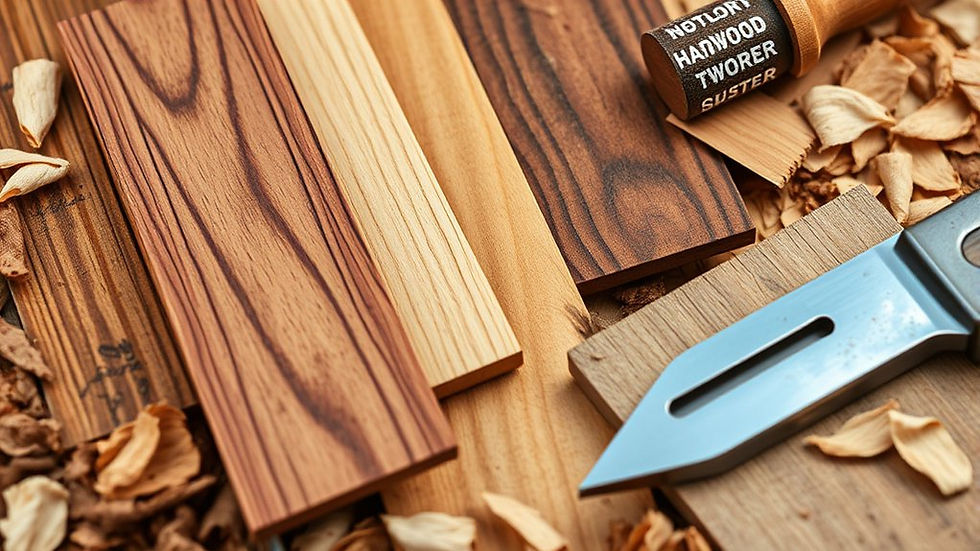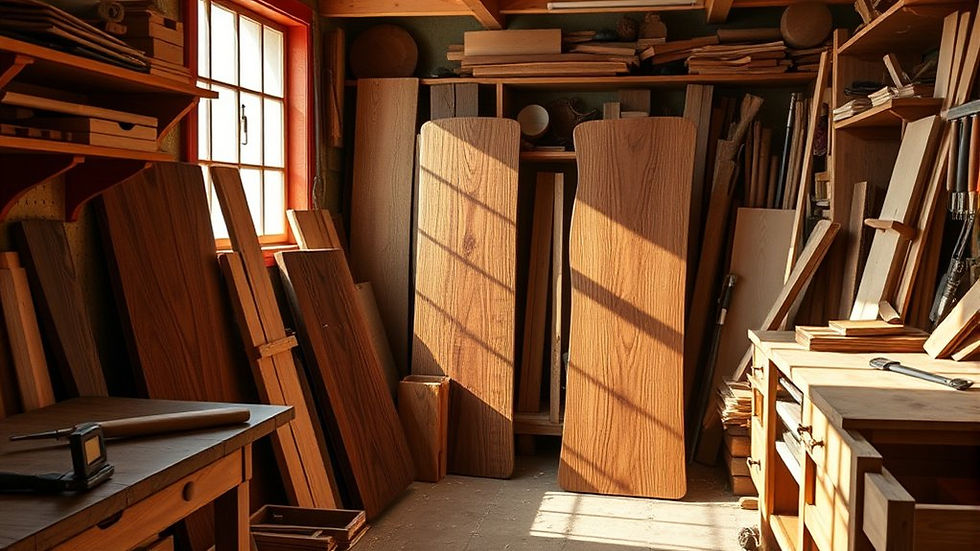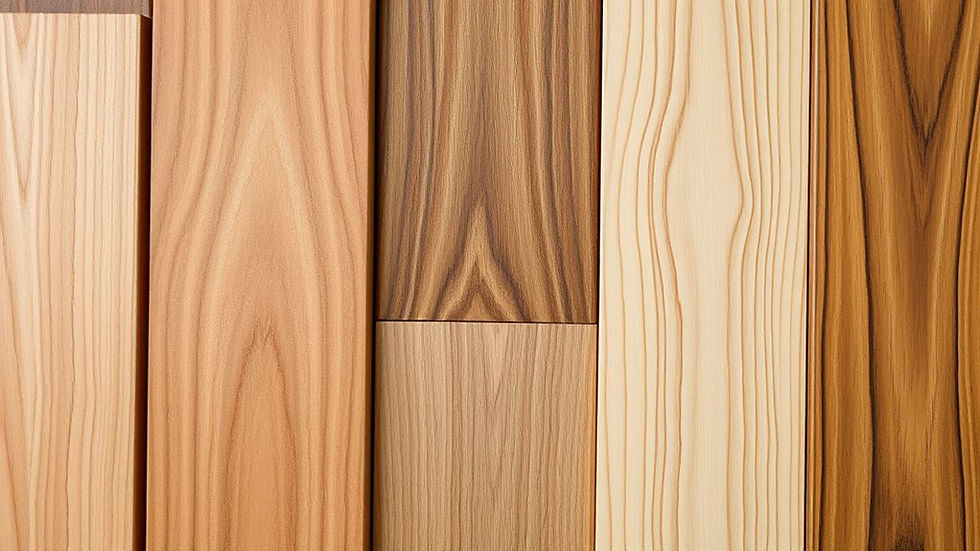Why Choose Specific Wood Types and Finishes?
- info9141069
- Aug 27
- 7 min read
Selecting the right wood types and finishes can make or break your woodworking project. Did you know that the choice of wood can significantly affect both the durability and aesthetics of your creation? Whether you’re a DIY enthusiast looking to create custom furniture or a professional carpenter seeking to elevate your craft, understanding the distinct properties of various woods is crucial. This article delves into the benefits of choosing specific wood types and finishes, addressing the common challenge of making informed decisions that align with both your budget and design needs. We’ll explore the advantages of hardwoods like oak and maple, and contrast them with the affordability and ease of softwoods such as pine. Additionally, we’ll discuss how the right finishes, such as polyurethane, not only enhance the visual appeal but also protect your work from wear and moisture. By the end, you’ll have a clearer understanding of how these choices can transform your woodworking projects into long-lasting, stunning pieces.

Understanding Hardwood and Softwood Differences
What Are the Key Differences Between Hardwoods and Softwoods?
When exploring woodworking, it’s crucial to grasp the distinctions between hardwoods and softwoods.
Hardwoods, sourced from deciduous trees, like oak, are characterized by their density and durability, making them ideal for furniture and high-traffic areas. With a Janka hardness rating of 1290, oak exemplifies strong resistance to wear.
Hardwoods, like oak, are dense and durable, perfect for furniture and high-traffic areas.
Conversely, softwoods such as pine, derived from evergreens, are lighter and more cost-effective, scoring a lower Janka rating of 690, making them suitable for framing and less demanding projects.
Hardwoods offer intricate grain patterns for aesthetic appeal.
Softwoods provide budget-friendly options with simpler grains.
For outdoor applications, hardwoods generally outperform softwoods in durability.
Choosing quality craftsmanship in hardwoods can significantly enhance the longevity of your woodworking projects.
Understanding these differences will help you choose the right materials for your woodworking projects.
For more detailed insights, see our guide on selecting the best wood types for your needs.
Evaluating Aesthetic Appeal in Wood Choices
When considering wood for its aesthetic appeal, the interplay of color, grain, and texture plays a crucial role in enhancing design.
But how do different hardwoods like walnut and cherry compare in their unique visual characteristics?
Understanding these distinctions can help you make an informed choice for your next project. Choosing high-quality cabinets made from solid maple, white oak, and birch can further elevate the overall look and durability of your space.
Color and Grain Variations
How do wood species differ in color and grain variations?
Wood species offer a variety of color and grain characteristics, which can significantly affect the aesthetic appeal of your projects.
For instance, cherry wood features a warm reddish-brown hue that darkens beautifully with age, adding to its sophistication. Walnut, recognized for its rich color and distinctive straight grain, presents an elegant choice for upscale designs.
Oak wood’s wavy grain provides visual interest, making it a favorite for furniture.
Different finishes can accentuate these natural attributes, enhancing overall beauty.
Understanding the aging process of each species helps predict the final appearance.
By selecting the right wood, you can create timeless beauty in your work. Additionally, utilizing premium materials like European styles can elevate your cabinetry projects to new heights.
For more insights on wood finishes, see our guide on enhancing natural features.
Texture and Visual Impact
How does wood texture and finish affect visual appeal?
The texture and finish of wood significantly influence the aesthetic impact of your projects. Choosing the right grain pattern and color enhances the overall design.
For instance, oak’s prominent grain adds depth, while maple’s fine grain provides a contemporary feel. Additionally, high-porosity woods like pine can absorb finishes effectively, enriching their natural beauty.
Opt for penetrating finishes like tung oil to highlight wood depth.
Use surface finishes such as lacquer for a glossy sheen.
Consider the porosity of your selected wood for even staining.
Understanding these factors is crucial in elevating your design. For more insights on wood selection, see our guide on enhancing project aesthetics.

Assessing Durability for Long-Lasting Projects
To ensure your wood projects last, it’s crucial to select the right type of wood and protective finishes.
Hardwoods like oak and maple, known for their high Janka hardness ratings, resist damage from dents and wear, making them suitable for areas with heavy foot traffic.
Moisture resistance also plays a vital role, particularly in outdoor environments. Low-porosity woods like maple effectively fend off moisture, reducing the risk of decay and pest infestations.
Choose durable wood types like oak or maple.
Apply protective finishes such as polyurethane for enhanced longevity.
Conduct regular maintenance to preserve the wood’s appearance and integrity.
For more insights on maximizing the lifespan of your projects, check out our guide on wood finishing techniques.
Workability and Ease of Use
How does woodworkability impact crafting projects?
Understanding woodworkability significantly influences crafting experiences, particularly for beginners.
Grasping woodworkability shapes crafting journeys, especially for novices.
Hardwoods like oak and maple, while durable, demand more effort and specialized tools due to their high density. In contrast, softwoods such as pine are easier to cut and shape, making them suitable for quick projects or novices.
The Janka hardness rating is a helpful benchmark; for instance, oak’s 1290 rating indicates a tougher workability level compared to pine’s more manageable 690.
Consider the finish: Wood like cherry offers excellent stain absorption.
Evaluate grain patterns: Hickory’s unique grain may require specific tools.
Match wood to project needs: Understanding characteristics like porosity is essential.
For more detailed guidance on selecting the right type of wood for your projects, see our guide on wood types and their uses.
Cost Considerations for Wood Selection
When choosing the right wood for your project, understanding the cost differences between hardwoods and softwoods is crucial.
But what factors should you consider to ensure you stay within your budget while selecting the perfect material for durability and aesthetic appeal?
Exploring the impact of supply and demand on wood prices can help clarify your options.
Hardwood vs. Softwood Prices
What’re the Price Differences Between Hardwood and Softwood?
When choosing between hardwood and softwood for your project, understanding their price variations is crucial for informed decision-making.
Hardwoods, such as oak and walnut, are typically more expensive, ranging from $3 to $15 per board foot, due to their density and aesthetic appeal.
In contrast, softwoods like pine and cedar are more economical, usually priced between $1 to $5 per board foot.
Hardwoods provide long-term value with lower maintenance.
Softwoods are ideal for budget-friendly projects.
Sustainable hardwood options tend to be pricier.
Ultimately, the choice hinges on balancing cost with durability and elegance.
For more insights on selecting the right wood type, check out our guide on wood characteristics.
Supply and Demand Impact
How does supply and demand affect wood selection?
Understanding the dynamics of supply and demand is crucial for making informed choices in wood selection. Hardwoods such as oak and walnut typically command higher prices due to their limited availability and high demand.
Seasonal spikes in demand can also lead to price increases for certain species, particularly during busy construction periods.
To navigate these challenges, consider locally sourced wood options to mitigate costs impacted by tariffs and shipping fees. Additionally, be aware that rarer species like teak and mahogany can see significant price hikes due to overharvesting and strict regulations.
Evaluate local suppliers for cost-effective choices.
Monitor market trends for seasonal pricing shifts.
Assess long-term value and durability when selecting wood types.
Dimensional Stability in Humid Environments
How does dimensional stability affect wood performance in humid environments?
Dimensional stability is crucial for wood in humid conditions, as it influences how well the material can withstand moisture-related changes.
Hardwoods, such as oak, typically exhibit greater stability than softwoods due to their density and reduced porosity. Oak’s Janka hardness rating of 1290 highlights its effective balance of strength and moisture resistance, making it a suitable choice for high-humidity areas.
To optimize wood performance, consider these tips:
Opt for hardwoods: They generally have better moisture resistance.
Review Janka hardness ratings: Higher ratings suggest enhanced stability.
Employ proper sealing techniques: This helps prevent moisture from penetrating the wood.
Choosing the right wood species is essential for ensuring long-lasting stability.
For more insights on wood selection, see our guide on choosing the best materials for your project.

Selecting the Right Finish for Protection and Beauty
How do you choose the best finish for wood?
Selecting the ideal finish for wood involves understanding the type of wood and its intended use. Softwoods like pine require a sealer for better adherence, while hardwoods can accommodate a wider range of finishes.
Softwoods need a sealer; hardwoods offer flexibility with various finishes.
Durability is crucial, especially in high-traffic areas; for instance, polyurethane is known for its excellent resistance to wear and moisture.
Consider your budget: Danish oil offers an affordable, natural appearance, while lacquer provides premium durability at a higher price point.
Explore eco-friendly options to improve indoor air quality during application.
Choose application methods based on experience level: beginners may prefer brushes or cloths, whereas seasoned woodworkers might opt for spray applications.
For a deeper understanding of various wood finishes, see our guide on selecting eco-friendly options.
Conclusion
Choosing the right wood and finish is essential for enhancing both the beauty and durability of your project. By applying the strategies outlined in this article, you can ensure that your creations withstand environmental challenges while maintaining their visual appeal. Understanding the nuances of various wood types and their finishes not only elevates your craftsmanship but also contributes to the longevity of your work. As you embark on this journey, consider exploring more tips on selecting materials and finishes that align with your vision. Ready to take the first step towards transforming your project into a masterpiece?






Comments